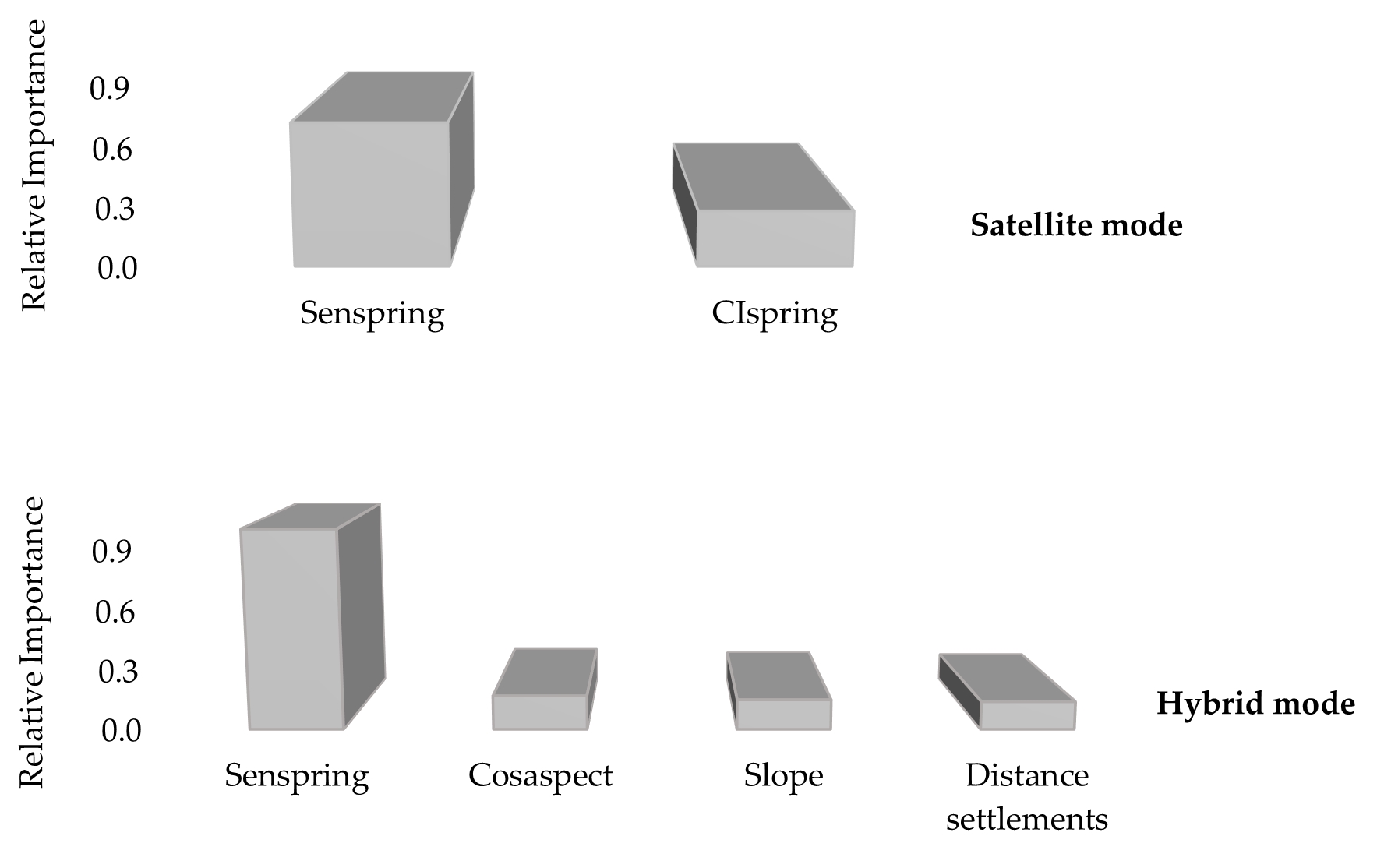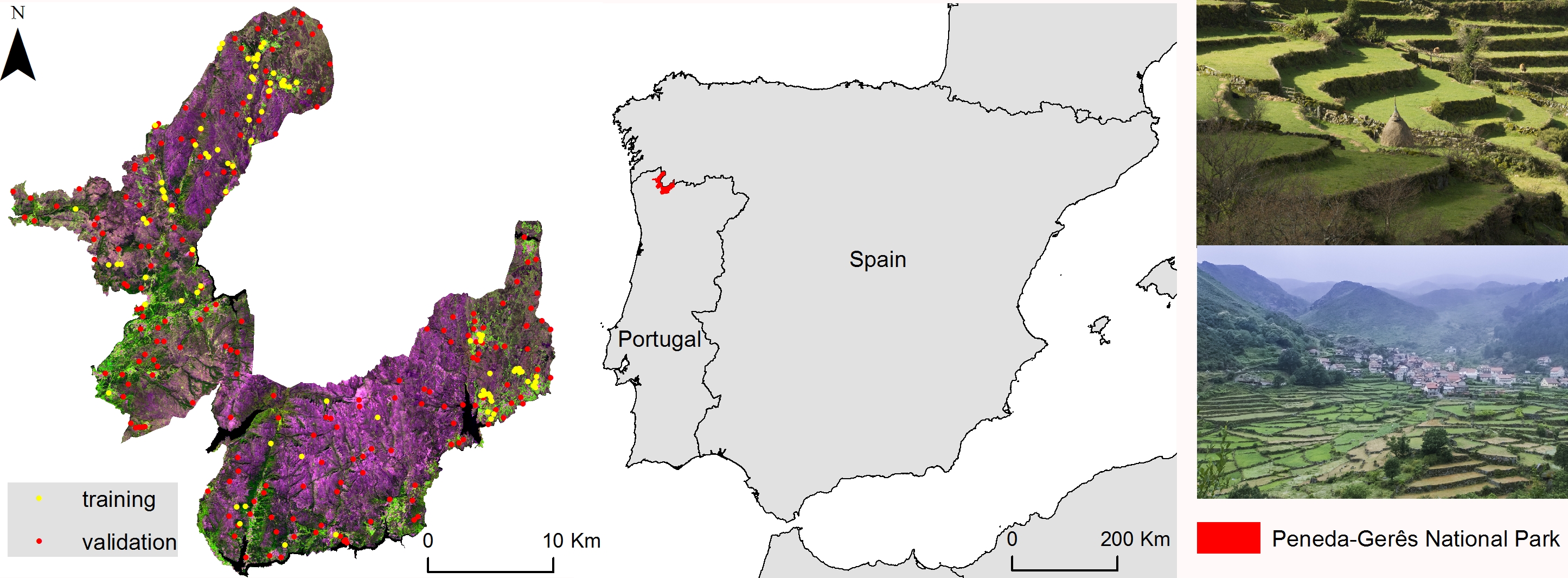The Peneda-Gerês National Park in northeast Portugal has been home to wild ponies for around 2500 years. Today, it also provides a rich habitat for wolves, foxes, wild boars, ibex, and deer. It also hosts otters, fish, frogs, salamanders, 147 different bird species (many migratory) and 15 bat species. Data from the Copernicus Sentinel-2 satellites are helping to safeguard this mountainous habitat.
One of the core missions of the European Union's Common Agriculture Policy (CAP) is to safeguard mountain pastoral systems, a man-made heritage where grasslands are key. To progress in this direction, habitat and plant diversity coverage are two dimensions in grasslands that require integrated monitoring to safeguard their role.
Data from the Sentinel-2 satellites of the European Union's Copernicus Programme were evaluated for integrated mapping of grassland coverage and plant diversity. Grassland coverage indicates the availability of the resource at the basis of pastoral systems, while plant richness coverage indicates ecosystem health, resilience and the nutritive value for animals feeding on grasslands. The integrated monitoring based on Earth observations could enhance the spatial-oriented management and conservation developed by the protected area authorities, which is an important feature for them, given the increasing scarcity of funding for large scale in-situ operations.
This considered, researchers from the Research Centre in Biodiversity and Genetic Resources (CIBIO-InBIO) at the University of Porto in Portugal started by assessing grassland coverage using a minimalist approach, assuming that high reflectance of grasslands in spring time could make it possible to separate grasslands from other cover types (for instance, cropland). This type of view could be of relevance when dealing with large amounts of data. Supervised mapping performed by the Greenness Tasselled Component (TCT greenness) and a set of 50 training sites recognisable as permanent grasslands was applied.
Classifications were run with three different algorithm classifiers (Random Forest (RF), Decision Trees (DT), K-nearest neighbours (KNN)) to identify the most accurate grassland coverage. To find the most accurate grassland coverage, accuracy assessment is performed according to Olofsson et al. [1,2] and mapped areas need to be within the lower 95% confidence value.
With grassland coverage completed, the target was to determine plant species richness over these areas. Usually, this information is available only at plot level, so spatial-explicit representation of species richness would be an improvement for the protected area.
To proceed in this direction, generalised linear modelling was used. Species-scaling relationships (e.g. species-area [3], species-energy [4,5], species-disturbance [6], and spectral heterogeneity [7]) were tested in the satellite (using only Copernicus Sentinel-2 derivatives) or hybrid mode (using Copernicus Sentinel-2 and other ancillary derivatives). Twenty-two grassland parcels served as input data for generalised linear modelling.
Copernicus Sentinel-2 is capable of obtaining better detail of Southern European mountain pastoral landscapes compared to other open access satellite data at moderate resolution. The high overall accuracy (0.97) of CIBIO-InBIO's best grassland coverage (based on RF) support this empirical evidence. The mapped area in 2016 (2672.7 ha) was within the 95% confidence value.
The measurement of plant species richness was achieved to a less accurate degree, highlighting the well-known complexity of retrieving biodiversity from space. The best averaged model in satellite mode (proxy by species-disturbance derivatives) explained 51% of variation in species richness (D2, Table 1). This is lower than registered previously by Fava [8] with spectro-radiometric measurements (66%) and by Lopatin [9] with Lidar data (72%), but in line with the decrease of model performance when models are applied to satellite images retrieving grassland properties [10].
The ratio (Senspring) between wavebands sensitive to vegetation structural properties (700–1300 nm) and plant pigment content (400–700 nm) was important to assess species richness.
"Overall, our findings encourage the continuous testing of Copernicus Sentinel-2 data to safeguard mountain pastoral system. The unexplained variance needs to be reduced, sampling and validation efforts extended," states Antonio T. Monteiro, now researcher at the IGOT Institute from the University of Lisbon.
"Copernicus Sentinel-2 provided an open access and detailed opportunity to spatial-oriented management and conservation of the Peneda-Gerês National Park. Before, this was only possible for small slices with expensive, very high resolution satellite imagery.
"For conservation purposes, south-eastern grasslands presented lower richness values and efforts should be targeted here to improve conditions. These areas coincide with the more densely inhabited areas in the Peneda-Gerês National Park," concluded Monteiro.
About the Copernicus Sentinels
The Copernicus Sentinels are a fleet of dedicated EU-owned satellites, designed to deliver the wealth of data and imagery that are central to the European Union's Copernicus environmental programme.
The European Commission leads and coordinates this programme, to improve the management of the environment, safeguarding lives every day. ESA is in charge of the space component, responsible for developing the family of Copernicus Sentinel satellites on behalf of the European Union and ensuring the flow of data for the Copernicus services, while the operations of the Copernicus Sentinels have been entrusted to ESA and EUMETSAT.
Acknowledgments:
ECOPOTENTIAL is a project funded by the European Union's Horizon 2020 research and innovation programme, which focuses its activities on a targeted set of internationally recognised Protected Areas, blending remote sensing Earth Observations with field measurements and data analysis. The project works side-by-side with 25 protected areas across Europe and beyond in providing the tools and models that make use of Copernicus Sentinel data for addressing this specific monitoring need (among others).
This article refers to the work conducted within the framework of the H2020 project ECOPOTENTIAL (Grant Agreement n. 641762) by researchers from the CIBIO-InBIO (Antonio T. Monteiro, Claudia Carvalho-Santos, Paulo Alves, João P. Honrado) in collaboration with University of New South Wales (Prof. Richard Lucas, Dr. Anthea Mitchell), University of Potsdam (Prof. Ariane Walz), University of Porto (Prof. Mário Cunha) and the Peneda-Gerês National Park. For additional details, please contact: monteiroantonio@edu.ulisboa.pt
References
1. Rocchini, D.; Balkenhol, N.; Carter, G.A.; Foody, G.M.; Gillespie, T.W.; He, K.S.; Kark, S.; Levin, N.; Lucas, K.; Luoto, M., et al. Remotely sensed spectral heterogeneity as a proxy of species diversity: Recent advances and open challenges. Ecological Informatics 2010, 5, 318-329.
2. Olofsson, P.; Foody, G.M.; Stehman, S.V.; Woodcock, C.E. Making better use of accuracy data in land change studies: Estimating accuracy and area and quantifying uncertainty using stratified estimation. Remote Sensing of Environment 2013, 129, 122-131.
3. Noordwijk, C.G.E.v.; Verberk, W.C.E.P.; Turin, H.; Heijerman, T.; Alders, K.; Dekoninck, W.; Hannig, K.; Regan, E.; McCormack, S.; Brown, M.J.F., et al. Species–area relationships are modulated by trophic rank, habitat affinity, and dispersal ability. Ecology 2015, 96, 518-531.
4. Bonn, A.; Storch, D.; Gaston, K.J. Structure of the species--energy relationship. Proceedings of the Royal Society B: Biological Sciences 2004, 271, 1685-1691.
5. Evans, K.L.; Greenwood, J.J.D.; Gaston, K.J. Dissecting the species–energy relationship. Proceedings of the Royal Society B: Biological Sciences 2005, 272, 2155-2163.
6. Mackey, R.L.; Currie, D.J. The diversity–disturbance relationship: Is it generally strong and peaked? Ecology 2001, 82, 3479-3492.
7. Duccio, R.; S., B.D.; Jean‐Baptiste, F.; M., F.G.; S., H.K.; Angela, L.; Harini, N.; Martin, W.; Nathalie, P. Satellite remote sensing to monitor species diversity: Potential and pitfalls. Remote Sensing in Ecology and Conservation 2016, 2, 25-36.
8. Fava, F.; Parolo, G.; Colombo, R.; Gusmeroli, F.; Della Marianna, G.; Monteiro, A.T.; Bocchi, S. Fine-scale assessment of hay meadow productivity and plant diversity in the european alps using field spectrometric data. Agriculture, Ecosystems & Environment 2010, 137, 151-157.
9. Lopatin, J.; Dolos, K.; Hernández, H.J.; Galleguillos, M.; Fassnacht, F.E. Comparing generalized linear models and random forest to model vascular plant species richness using lidar data in a natural forest in central chile. Remote Sensing of Environment 2016, 173, 200-210.
10. Meyer, H.; Lehnert, L.W.; Wang, Y.; Reudenbach, C.; Nauss, T.; Bendix, J. From local spectral measurements to maps of vegetation cover and biomass on the qinghai-tibet-plateau: Do we need hyperspectral information? International Journal of Applied Earth Observation and Geoinformation 2017, 55, 21-31.



